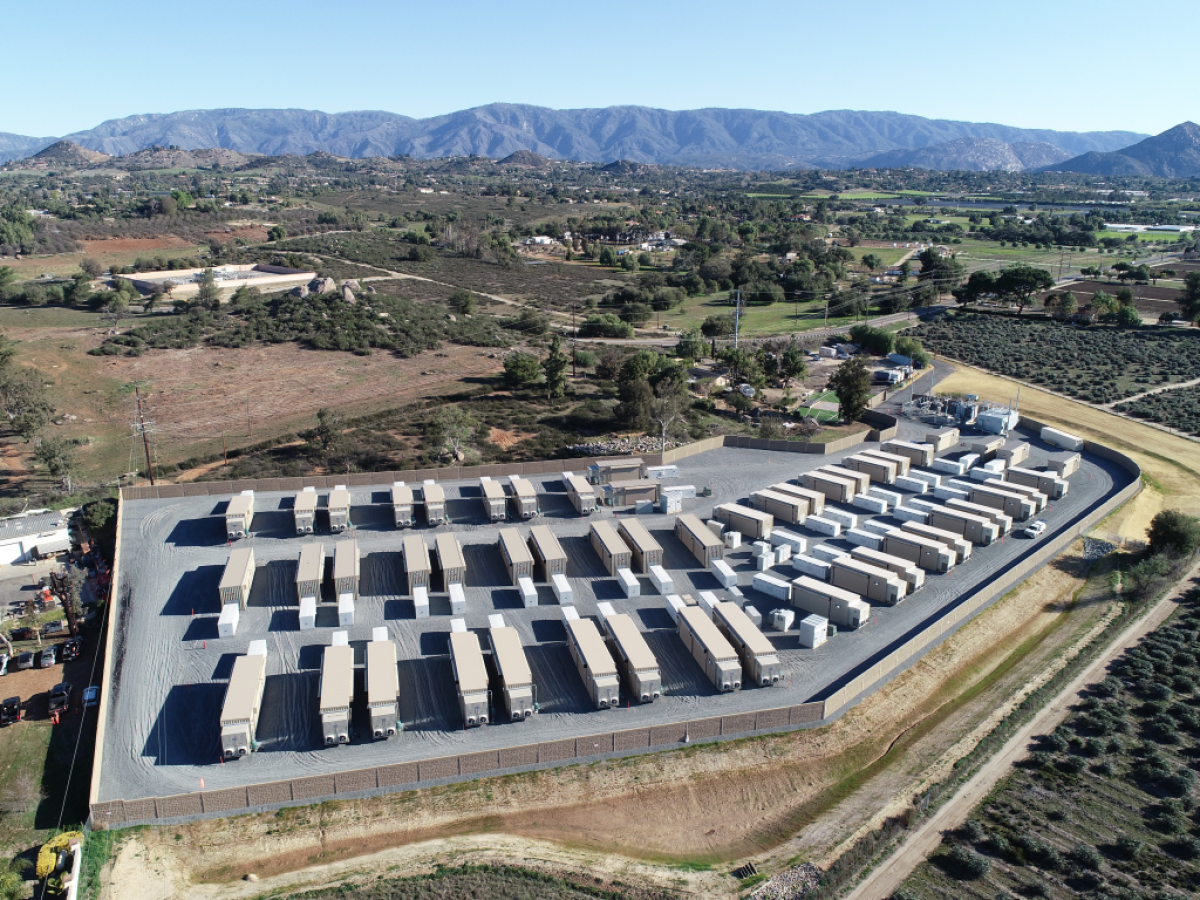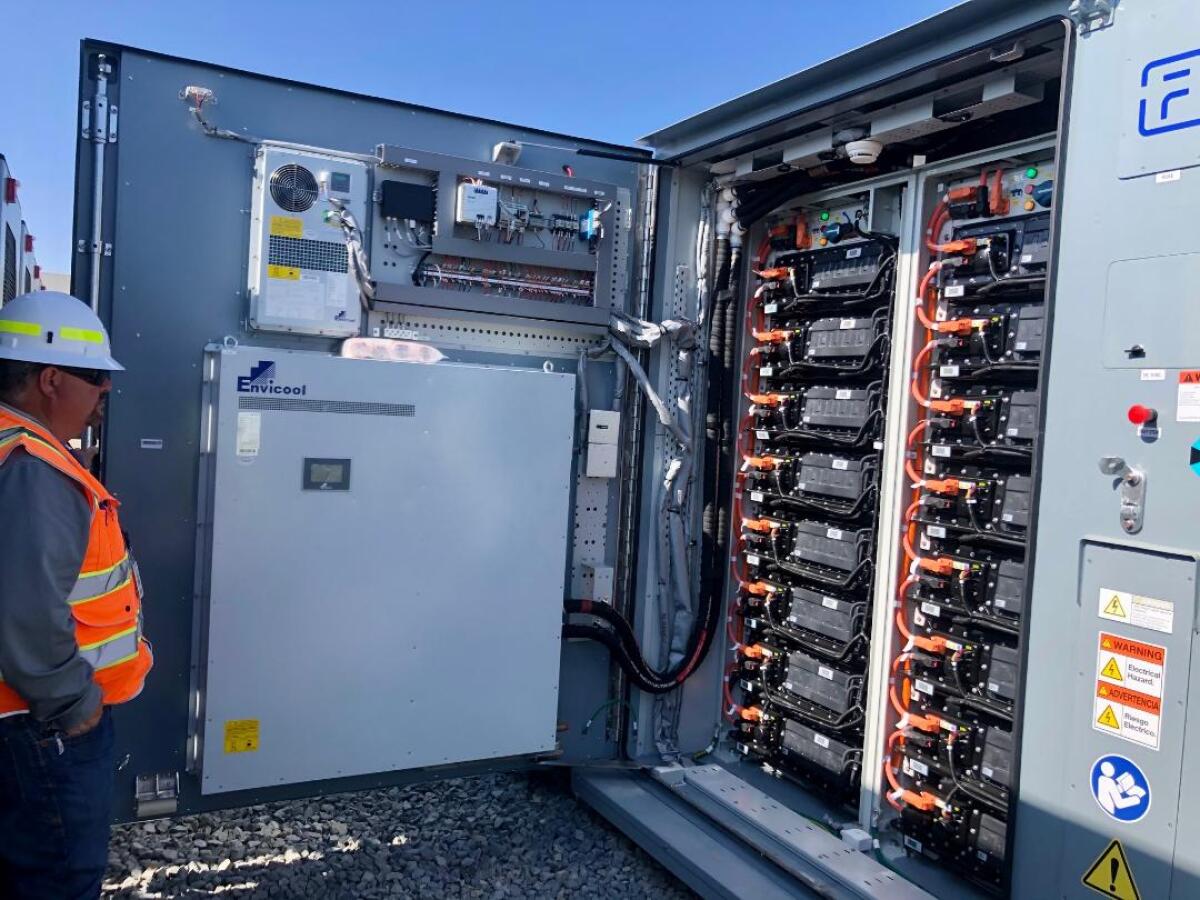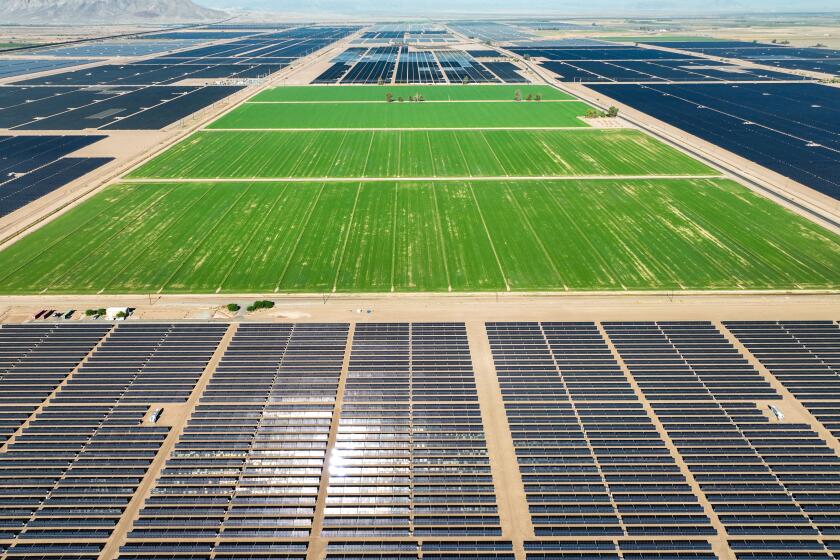Battery storage is a key piece of California’s clean energy transition. But there’s a problem with fires

- Share via
If California is going to meet its ambitious goals to transition from electricity using fossil fuels, the state will need energy storage to shoulder a significant amount of the load.
The number of installations is on the rise, but a persistent problem keeps coming up — fires igniting at battery storage facilities.
Most recently, a fire broke out at the Valley Center Energy Storage Facility in San Diego County on Sept. 18. Although fire officials said the blaze was put out in about 45 minutes and extinguished by the site’s internal fire prevention system, businesses and the small number of homes within a quarter-mile of the industrial park where the facility is located were evacuated and shelter-in-place orders were in effect within a half-mile of the site.
State policymakers are still bullish on battery storage but concede that issues leading to “thermal runaway” — where excessive heat inside a battery leads to a chemical reaction that spreads to other batteries in a chain reaction — need to be resolved.
“The stakes are high,” said David Hochschild, chair of the California Energy Commission. “We have to have effective storage. Generally, I’m very pleased with the performance of the storage fleet in California, but we cannot have fires on a regular basis.”
One of America’s reddest states is seeking 100% clean energy. But does hydropower count as clean?
Why batteries are important
Energy storage has taken on a higher profile in recent years as more renewable sources of power have come onto California’s electric grid.
Solar production may be abundant during the day but practically vanishes after sunset or when smoke and clouds obscure the skies. And when the wind doesn’t blow, production from wind farms peters out. Energy storage — particularly from batteries — is seen as a key way to fill the gaps.
Storage systems take solar power generated during the day and discharge the electricity later, especially from 4 to 9 p.m. when California’s grid is under the most stress.

Batteries can help replace natural gas “peaker plants” used during those critical hours when customers crank up their air conditioners, helping reduce the risk of rotating power outages.
Battery storage also delivers electricity to areas prone to Public Safety Power Shutoffs — the practice in which utilities de-energize power circuits, usually in rural and backcountry areas, during windy and dry conditions to reduce the risk of power lines falling and igniting a wildfire.
Bulking up on energy storage is crucial for California to reach its target of deriving 100% of electricity from carbon-free sources by 2045.
Four years ago, the state counted a mere 250 megawatts of battery storage available to the California Independent System Operator, which manages the grid for 80% of the state and a small part of Nevada.
By the end of this year, that number is expected to grow to 8,000 megawatts. And the amount of battery storage integrated fully into the grid is expected to increase to 19,500 megawatts by 2035 and 52,000 megawatts by 2045.
Building out all that battery storage infrastructure gets passed onto California ratepayers in the monthly utility bills they pay.
America needs lots of clean power, fast. Should it go on public lands or on rooftops?
What happened at Valley Center?
San Diego-based renewable energy company Terra-Gen owns and operates the 139-megawatt, 560 megawatt-hour Valley Center Storage Facility that produces enough electricity to power up to 140,000 homes for four hours on a single charge. Located on seven acres in a commercial-industrial zone, the facility opened in February 2022 and delivers energy to a nearby SDG&E substation.
The Sept. 18 fire is under investigation, with fire officials saying they expect a final determination coming in about two months. The storage facility resumed operations the following day.
The LG batteries at the site are made of lithium, nickel, manganese and cobalt, and Terra-Gen officials said the facility has no history of thermal runaway events.
Terra-Gen officials in an email said Valley Center neighbors “should know that the facility’s safety systems are designed to operate 24/7” and are designed to “prevent small events from becoming larger events.”
“Our company goes beyond standard regulatory requirements and conducts emergency response training with first responders on a regular basis,” Terra-Gen spokesperson Amy Roth said.
Replacing agriculture with solar panels could help solve the West’s energy and water crises. But farmers are fighting back.
Other incidents
Lithium-ion batteries that power electronic devices such as smartphones and laptops can pose a fire risk if they overheat, get damaged or are defective.
Battery flaws in electric vehicles have prompted carmakers to issue recalls. In January, a massive fire broke out at a warehouse in France that stored thousands of automotive lithium-ion batteries. It took roughly 100 firefighters to douse the blaze.
Many of the same materials in EVs are used at battery energy storage sites.
In September 2022, a Tesla Megapack caught fire at a battery storage facility operated by Pacific Gas & Electric in the Northern California town of Moss Landing. No injuries were reported, but California Highway Patrol closed a section of Highway 1 and redirected traffic away from the site for hours.
An explosion in 2019 at an energy storage facility in Surprise, Ariz., injured nine first responders. This summer, fires broke out at three separate battery projects in New York state, although no injuries were reported.
A fire last month at a large-scale facility in Australia nicknamed Big Bessie led emergency officials to warn nearby residents to stay indoors to avoid hazardous fumes.
Billionaire Phil Anschutz — who owns the Coachella music festival, the Los Angeles Kings hockey team and L.A.’s Crypto.com Arena — is preparing to build the nation’s largest wind farm. We traveled the route.
What’s causing the fires?
The lithium-ion batteries made with nickel manganese cobalt have high energy density, which makes them attractive for use in storage facilities. But in light of thermal runaway incidents, there’s been a movement toward lithium iron phosphate batteries that operate at lower temperatures and are less prone to fires.
Although changing or adjusting battery chemistry is important, there’s also a focus on making sure the battery arrays are properly wired and the fire prevention systems inside the storage containers don’t malfunction.
“The industry is learning how to take the basic building blocks with the energy cells, devices and battery management systems and integrating them into complete projects,” said Scott Murtishaw, executive director of the California Energy Storage Alliance. “There’s going to be learning by doing.”
But the problems underscore the arguments made by critics of battery storage, who not only cite fires but point to its relatively high cost compared to conventional sources of power.
A study released in June by the National Renewable Energy Laboratory projected costs in 2030 for four-hour storage ranging from $245 per kilowatt-hour to $403. The industry’s breakthrough price is generally considered to be about $100 per kilowatt-hour.
“There’s a huge amount of money going into making better, safer, more energy-dense batteries that can operate at lower temperatures,” said Hochschild of the California Energy Commission. “It’s definitely a major risk we need to manage and focus on.”
Those words don’t comfort Phyllis Laderman, a resident of Eden Valley, an unincorporated community between Escondido and San Marcos. She’s opposed to renewable energy company AES constructing a proposed battery storage project in her neighborhood.
News of the Valley Center fire “made me very nervous and scared about the proposed facility here,” Laderman said. “It seemed to underscore all of the points we’ve made — that these battery energy [projects] really don’t belong anywhere near homes and where people live.”
At 400 megawatts and 1,600 megawatt-hours of capacity, the AES Seguro Storage project would match the Moss Landing battery storage facility in Monterey County as the largest in the state. It would discharge enough stored energy to power about 300,000 homes for four hours.
“We’re not saying that these facilities are a bad thing,” Laderman said, “but there need to be rules and regulations about where they are allowed to be.”
AES officials say they plan to use the most up-to-date technology to ensure the batteries are safe. AES has tentative plans to have the project online by the end of 2026.
Nikolewski writes for the San Diego Union-Tribune. Union-Tribune staff writer David Garrick contributed to this report. This article was distributed by Tribune Content Agency.
More to Read
Inside the business of entertainment
The Wide Shot brings you news, analysis and insights on everything from streaming wars to production — and what it all means for the future.
You may occasionally receive promotional content from the Los Angeles Times.













